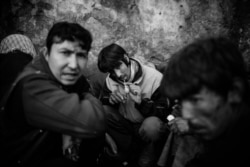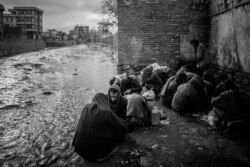Mohammed Reza, 37, sits on a bus stop in the Pul-e-Sukhta area in Kabul, rays of sun illuminating his fatigued tanned face. Just several meters away, under a bridge, down a damp sloping riverbank filled with a stale mixture of trash and human waste is a place he calls home.
It’s also a place where each day, dozens of drug users meet amid fumes of heroin and the increasingly popular crystal meth.
Since the beginning of the coronavirus pandemic, police have targeted addicts in these areas in an effort to clear Afghanistan’s streets of drug users like Mohammed Reza.
It was early April when the police began to use force, Mohammed Reza recalls. They first offered to transport the men sitting under the bridge to rehab centers. But when few of them agreed to go voluntarily, the police began to pick them up, one by one, and force them into minibuses. Dozens of drug users escaped through the water under the bridge as police shot bullets into the air.
“Earlier, they used to take 10, 15 or 20 people, now they take a hundred. They fear that the coronavirus will spread in our group,” Mohammed Reza says.
World's largest opium producer
Afghanistan is the world’s largest opium producer with 80% of the drug originating in the country. While most of the drugs are sent abroad, heroin has taken a heavy toll on Afghanistan, too. According to the 2015 Afghanistan National Drug Use Survey, about 11.1% of the local population was drug positive.
A scene of small groups of men, their heads covered with scarves, squatting while inhaling drugs, has become part of the landscape of many Afghan cities. Drug use and abuse increased following the U.S. invasion in 2001. At that time, poppy fields covered roughly 74,000 hectares, by 2019 that had increased to 160,000 hectares.
Today, the Taliban, local warlords and criminal organizations benefit from the growing and trafficking of drugs. For many impoverished farmers, however, poppy cultivation has been the only source of income. According to the Afghanistan Research and Evaluation Unit, the local research center, the drug business is the largest industry in the country, accounting for up to 10% of the GDP and employing close to 500,000 people.
Under the bridge in Pul-e-Sukhta, dozens of men squat around in small groups inhaling the fumes around their heads. Others sit alone in a gloomy stupor. Many lie down in tents or on the ground. Some will never wake up. According to Mohammed Reza, about seven people each week died under the bridge during the winter, either through overdose or because of the frigid conditions.
“I tried heroin for the first time when I lived in Iran. I had friends which were [a] bad influence. We had picnic parties all nights and most of my friends used drugs there,” Mohammed Reza said. That was 14 years ago. “Then I stopped using for a few months, but when I returned to Afghanistan eight years ago, I started again.”
Mohammed Reza says he believes the lack of jobs and family support are among the reasons people like him turn to drugs. About 6 million Afghans have lost their jobs due to the pandemic. Nearly 80% of the population lives near the poverty line, according to the Biruni Institute, a local economic think tank. Those statistics mean Afghan drug users have even fewer incentives to leave the streets.
Mental health
Mohammad Shafi Azim is the director of the psychiatric ward in the Kabul Mental Health Hospital, the only public clinic that admits drug users for treatment. His ward has 20 beds, but only four patients. People are trying to avoid hospitals during the pandemic.
“Most patients are not only addicted, they also suffer from psychological issues like depression or anxiety,” he says, sitting in his office. “After leaving our hospital, after a month, two or three, many patients start using again. There are many reasons for this situation: bad economic climate, bad environment, lack of support, divorces, the visibility of drugs, and easy access. They all push people to start smoking again.”
But cultural factors play a role, too. In some Afghan provinces, opium is used as a natural remedy for many ills.
“I once asked my patient how long he had been addicted. He answered 42 years. I asked how old he was. He said he was 42. How is this possible? When he was a baby, his mother used to give him opium when he cried. This is common,” Azim says.
Tough to quit
Mohammad Daoud, 35, a husband and father of four who had been using for 19 years, was determined to quit heroin and join his family in Turkey. But only one day after leaving a rehab center in Herat, where he spent four months, he returned to the streets.
“I don’t have a job, so I came here to see my old friends,” he says. “We need help, we need the government to create jobs for us. I think most people take drugs because of unemployment, poverty and war.”
During the pandemic, the government has created an additional 2,000 places in rehab centers across the country for drug users, according to the Ministry of Public Health. The ministry pays the salaries of nongovernmental organizations (NGO) workers employed in those centers.
“During the COVID-19 health crisis in Herat province, the government has helped about 12 private treatment camps for drug users with pharmaceuticals, hygiene kits, and food packages,” Abdul Shukoor Haidary, senior technical manager at the Directorate of Drug Demand Reduction, told VOA.
“With the development of special centers for homeless drug users in Kabul and Kandahar, the solution is to collect drug addicts from the streets in cooperation with the Ministry of Interior Affairs and return them to the rehabilitation centers,” he said.
But the initiative might be too little, too late.
“The government doesn’t want to treat us, they want to get rid of us. We should die under the bridge and our bodies should be wiped away by the waters,” Mohammed Reza says bitterly. “I never tried to get sober in Afghanistan. I would like to stop, but I don’t have a job. There is no way out.”













